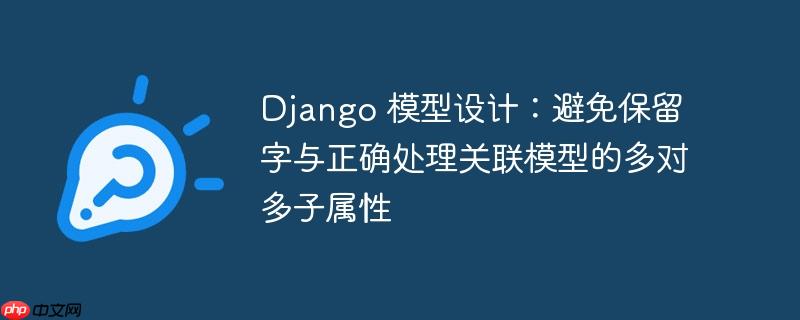
在django模型设计中,我们经常需要处理复杂的实体关系,例如一个资产(asset)拥有一个类型(assettype),而这个类型又关联了多个子类型(subassettype)。当尝试在asset模型中直接引用assettype的subtipos(多对多关系字段)来定义subtipo(外键)时,开发者可能会遇到attributeerror,这通常源于对python保留字的不当使用以及对django外键定义机制的误解。
在Python中,一些单词被语言本身保留,用于特定目的(例如type, class, def, for, if等)。将这些保留字用作变量名、函数名或类属性名(包括Django模型字段名)会导致语法错误、运行时异常或难以调试的逻辑问题。
原始代码中,Asset模型中的字段type = models.ForeignKey(AssetType, ...)就是一个典型的例子。type是Python的内置函数,用于获取对象的类型。当您尝试在模型中将其用作字段名时,Python解释器会混淆这个字段名与内置的type函数,从而导致后续操作(如type.subtipos)失败,抛出AttributeError。
正确做法: 始终避免使用Python保留字作为模型字段名。选择一个描述性强且不冲突的名称。例如,将type重命名为asset_type或tipo。
from django.db import models
class SubAssetType(models.Model):
name = models.CharField(max_length=50)
slug = models.SlugField()
descripcion = models.TextField(null=True, blank=True)
def __str__(self):
return self.name
class AssetType(models.Model):
name = models.CharField(max_length=50)
slug = models.SlugField()
descripcion = models.TextField(null=True, blank=True)
subtipos = models.ManyToManyField(SubAssetType, blank=True)
def __str__(self):
return self.name
class Asset(models.Model):
# Atributos nominales
name = models.CharField(max_length=50)
slug = models.SlugField()
descripcion = models.TextField(null=True, blank=True)
# Atributos de valor
# 将 'type' 重命名为 'tipo' 或 'asset_type'
tipo = models.ForeignKey(AssetType, on_delete=models.CASCADE, related_name='assets_by_type')
# subtipo 的正确定义将在下一节讨论
# subtipo = models.ForeignKey(SubAssetType, on_delete=models.CASCADE, related_name='assets_by_subtype')
def __str__(self):
return self.name在上述代码中,我们将Asset模型中的type字段更名为tipo,这消除了与Python内置type函数的冲突。同时,为了后续查询的便利性,我们为ForeignKey字段添加了related_name参数。
原始代码中subtipo = models.ForeignKey(type.subtipos, on_delete=models.CASCADE)的定义是错误的,原因有二:
正确的外键定义:subtipo字段应该直接指向SubAssetType模型,表示一个Asset实例关联了一个具体的SubAssetType实例。
from django.db import models
from django.core.exceptions import ValidationError
# ... (SubAssetType and AssetType models as defined previously)
class Asset(models.Model):
# Atributos nominales
name = models.CharField(max_length=50)
slug = models.SlugField()
descripcion = models.TextField(null=True, blank=True)
# Atributos de valor
tipo = models.ForeignKey(AssetType, on_delete=models.CASCADE, related_name='assets_by_type')
# subtipo 直接指向 SubAssetType 模型
subtipo = models.ForeignKey(SubAssetType, on_delete=models.CASCADE, related_name='assets_by_subtype')
def __str__(self):
return self.name
# 强制业务逻辑约束的方法将在 clean() 方法中实现
def clean(self):
super().clean()
# 只有当 tipo 和 subtipo 都已选择时才进行验证
if self.tipo and self.subtipo:
# 检查所选的 subtipo 是否在当前 tipo 的 subtipos 列表中
if not self.tipo.subtipos.filter(pk=self.subtipo.pk).exists():
raise ValidationError(
{'subtipo': '所选的子类型不属于当前资产类型。请选择与资产类型匹配的子类型。'}
)强制业务逻辑约束: 外键定义本身无法强制“subtipo必须属于tipo的subtipos”这一业务逻辑。这种复杂的验证通常通过以下方式实现:
clean()方法是Django模型提供的一个钩子,用于执行模型实例的自定义验证逻辑。当调用模型的full_clean()方法时(例如在Django Admin保存模型时,或通过ModelForm保存时),clean()方法会被触发。
在Asset模型的clean()方法中,我们可以检查self.subtipo是否是self.tipo所关联的subtipos之一。
from django.db import models
from django.core.exceptions import ValidationError
# ... (SubAssetType and AssetType models)
class Asset(models.Model):
# ... (fields as defined above)
tipo = models.ForeignKey(AssetType, on_delete=models.CASCADE, related_name='assets_by_type')
subtipo = models.ForeignKey(SubAssetType, on_delete=models.CASCADE, related_name='assets_by_subtype')
def __str__(self):
return self.name
def clean(self):
"""
自定义验证方法,确保 subtipo 属于 tipo 的 subtipos 列表。
"""
super().clean() # 调用父类的 clean 方法
# 只有当 tipo 和 subtipo 都已设置时才进行验证
if self.tipo and self.subtipo:
# 使用 .filter().exists() 是查询关联对象最高效的方式
if not self.tipo.subtipos.filter(pk=self.subtipo.pk).exists():
raise ValidationError(
{'subtipo': '所选的子类型不属于当前资产类型。请选择与资产类型匹配的子类型。'}
)注意事项:
对于通过Web表单提交的数据,可以在ModelForm中实现类似的验证逻辑。这提供了更友好的用户体验,因为错误会在用户提交表单时立即显示。
from django import forms
from .models import Asset, AssetType, SubAssetType
class AssetForm(forms.ModelForm):
class Meta:
model = Asset
fields = '__all__' # 或者指定需要包含的字段
def clean(self):
"""
自定义表单验证方法,确保 subtipo 属于 tipo 的 subtipos 列表。
"""
cleaned_data = super().clean()
tipo = cleaned_data.get('tipo')
subtipo = cleaned_data.get('subtipo')
# 只有当 tipo 和 subtipo 都存在于表单数据中时才进行验证
if tipo and subtipo:
if not tipo.subtipos.filter(pk=subtipo.pk).exists():
self.add_error('subtipo', '所选的子类型不属于当前资产类型。') # 将错误添加到特定字段
return cleaned_data注意事项:
通过遵循这些原则,您可以构建健壮、可维护且符合业务逻辑的Django模型。
以上就是Django 模型设计:避免保留字与正确处理关联模型的多对多子属性的详细内容,更多请关注php中文网其它相关文章!

每个人都需要一台速度更快、更稳定的 PC。随着时间的推移,垃圾文件、旧注册表数据和不必要的后台进程会占用资源并降低性能。幸运的是,许多工具可以让 Windows 保持平稳运行。

Copyright 2014-2025 https://www.php.cn/ All Rights Reserved | php.cn | 湘ICP备2023035733号